Top News
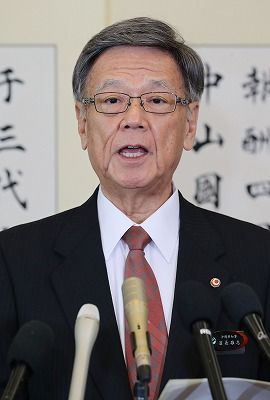
January 4, 2018 Ryukyu Shimpo Digital Edition
Okinawa Governor Takeshi Onaga made his New Year’s resolution with regards to the new base construction issue in Henoko while giving his year-opening address to prefectural government employees on the morning of January 4, stating, “We can absolutely not forgive the new base construction done without the consent of the Okinawan people.
The Okinawan government will do everything we can to work towards a solution.
” Onaga also reiterated that, “Hereafter we will continue to make the prevention of new base construction at Henoko a pillar of the Okinawan government, based on the spirit of protest.”
Additionally, he offered a resolution to, “do everything in his power to realize a treaty that closes MCAS Futenma and withdraws the Osprey helicopters from the islands.”
Onaga harshly condemned that, “the easing of the excessive burden of U.S. military bases on Okinawa is still far away,” referencing the number of incidents from the previous year including a part falling on an elementary school from a military helicopter and a fatal drunk driving accident involving a U.S. Marine.
On the economic front, Onaga noted the positive economic trends for Okinawa, including the expansion of demand in the tourism industry coming it at over 9,000,000 visitors in the previous year, as well as the job-to-applicants ratio reaching its highest level ever after a strong recovery.
He also expressed his hopes into strengthening Okinawa’s logistical capacity with the MICE multi-purpose convention center as well as a harbor for large-scale cruise ships.
With regards to social welfare, the governor resolved to, “Eliminate the school waiting lists as part of the effort to create a society where everyone can live and prosper without worry.”
He also raised examples of other policies such as policies to fight childhood poverty, care for the elderly, as well as healthcare policies including the construction of a new hospital.
At the start of the address, Governor Onaga stated, “At the outset of my 4th New Year as Governor, I am starting with a fresh heart meant to drive a government that will meet the expectations of the Okinawan people this year.”
Furthermore, he reflected on the previous year, commenting, “We made effective progress in all fields including the economy, education, welfare, and healthcare.”
The Governor also expressed enthusiasm for the upcoming National Skills Competition and the Abilympics, and what it can do for promoting employment.
He also mentioned a desire to work towards getting the northern part of Okinawa’s main island, Iriomote Island, and Amami as World Heritage sites.
(English translation by T&CT and Sam Grieb)
Go to Japanese
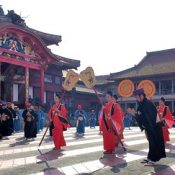
January 3, 2018 Ryukyu Shimpo
An event called Shinshun no Utage or New Year’s Banquet was held at Shuri Castle in Naha on January 1.
Three scenes from the Chouhaiokishiki or Imperial Court New Year’s morning ceremony from the Ryukyu Kingdom era were revived on the morning of January 1.
The first scene is called Ninufanu-unufe, in which people playing the role of King, the executives, and representatives of the general public pray for a peaceful year to the gods. While uzagaku music was being played, the King and Queen appear and approach the Una forecourt. The King and his people pray toward the alter while chanting wansui, Okinawan for the Japanese “banzai,” to celebrate the New Year.
Many visitors gathered at the court to watch the solemn celebration performed by the King and others in gorgeous costumes.
Yoshihiro Shimada, a 36 year-old company worker from Tokyo said “It was solemn, and it had the feeling of continental Asian culture that is not present in mainland Japan.”
Free jasmin tea and amazake, a sweet fermented sake, were distributed at the Shichanu-una.
The New Year’s banquet was performed through January 3.
(English translation by T&CT and Sayaka Sakuma)
Go to Japanese
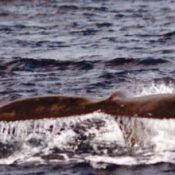
December 29, 2017
By Hirokazu Otsubo, Correspondent for the Ryukyu Shimpo
(Zamami) This season’s whale watching tours started in Zamami Village on December 27.
On that day, a warden from the village’s Whale Watching Association spotted one humpback whale from a field observatory.
The whale, which swam leisurely through the Kerama Straight, could also be seen from a whale watching boat, and spectators raised their voices in excitement.
Boat captain Kiyoshi Miyagi, 57, said, “I’m glad the whales returned this season.”
According to the Whale Watching Association, the first whale of the season was observed on December 21. Tours will be held until April 5.
(English translation by T&CT and Sandi Aritza)
Go to Japanese
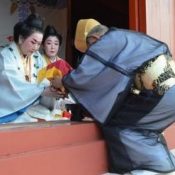
December 24, 2017 Ryukyu Shimpo Digital Edition
The traditional Okinawan ceremony, known as the, “Nubi offering ceremony,” where the year’s first water drawn from Hedo in Kunigami is presented as an offering, was held in the afternoon of December 24 at Shuri Castle in Naha.
In the ceremony, a man playing the role of an official from the royal Okinawan government will approach a woman playing the role of a high-priestess, dubbed Amushirare, and offer the year’s first-drawn water, praying for peace in the coming year as well as health and longevity for the Okinawan people.
The ceremony was hosted by the Shuritonokuracho neighborhood council of Naha.
Yoshimitsu Momohara, vice-president of the neighborhood council, played the role of the imperial official who offered the nubi to the Amushirare high-priestess.
He commented, “I was able to perform my role with the solemn approach required.
I would like to get more young people involved so that this traditional ceremony can be passed down.”
(English translation by T&CT and Sam Grieb)
Go to Japanese
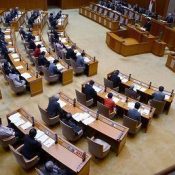
December 21, 2017 Ryukyu Shimpo Digital Edition
In response to the accident in which a window of a U.S. military helicopter fell on the Futenma Daini Elementary School in Ginowan, Okinawa and the accident in which it appeared that a component of a U.S. military helicopter of the same type fell on a nursery school in the same city, the Okinawa Prefectural Assembly held a general meeting on December 21 where a protest resolution and opinion statement were passed unanimously demanding that flights by aircraft stationed at Marine Corps Air Station Futenma over civilian areas be suspended. On December 22, representatives from the Prefectural Assembly visited relevant agencies in the prefecture to deliver copies of the resolution.
The statement asserts that “That U.S. military aircraft accidents occur unceasingly keenly indicates that the U.S. military’s safety management systems and reoccurrence prevention efforts are not functioning,” and demands that “the U.S. military and the Japanese and U.S. governments make every effort to relieve the concerns of Okinawans.”
The resolution then calls for (1) investigation into the causes of the accidents and swift public announcement of the results, (2) suspension of flight exercises by U.S. military aircraft stationed at MCAS Futenma over nursery schools, schools, hospitals, houses, and other civilian spaces, and (3) cessation of operations at MCAS Futenma within five years, as promised by the Japanese government.
(English translation by T&CT and Sandi Aritza)
Go to Japanese
December 24, 2017 Ryukyu Shimpo
On December 23 at a meeting of Takae’s ward representatives, they unanimously decided to return the letter of gratitude that the U.S. military delivered in regard to the U.S. helicopter that made an emergency landing and burst into flames in Takae, Higashi Village.
The military sent the letter to 64-year-old Akira Nishime, the landowner upon whose property the helicopter landed, and to the representatives of Takae Ward. Nishime said, “Why should I accept a letter of gratitude in regard to a helicopter going up in flames on my land? I don’t understand the meaning [behind the gesture].”
The U.S. military delivered the letter on December 15.
According to Nishime, he proposed returning the letter to the U.S. military at the meeting of Takae’s ward representatives.
His proposal was unanimously approved.
Takae’s ward representatives plan to return the letters that they and Nishime received to the U.S. military.
Nishime said, “Ward residents are requesting an investigation into the cause of the accident and an accompanying report.
I don’t plan to accept the letter of gratitude now or hereafter.”
(English translation by T&CT and Erin Jones)
Go to Japanese
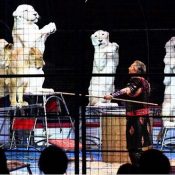
December 16, 2017 Ryukyu Shimpo
The opening of the Kinoshita circus was held as part of the launch event for the Ryukyu Shimpo main building on December 15 at the Toyosaki Special Venue in Tomigusuku city.
It has been five years since the circus was last held in Okinawa. There was a long line of people waiting in anticipation for the opening of the show, and the venue was crowded with many families.
Two shows were held following the opening ceremony.
Both shows were sold out, with a total 4000 audiences visiting the show. The audiences enjoyed a dream-like world with a thrilling trapeze act, an attraction called the “steep rope,” in which the performer tiptoes up a steep rope, and performances by humorous clowns.
The circus will performed in Okinawa until February 26, 2018. The show will be closed every Thursday except for January 4 as well as New Year’s Eve, January 10, and February 14.
For more details, please contact the circus office’s Okinawa branch at 098-856-0045.
(English translation by T&CT and Sayaka Sakuma)
Go to Japanese
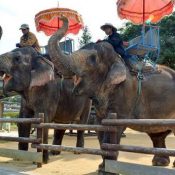
December 15, 2017 Ryukyu Shimpo
Two Asian elelphants, Buntoon and Tonsai, were debuted on December 14 at the Okinawa Zoo & Museum. The two elephants are visiting Okinawa from the Tohoku Safari Park to stay through the winter.
The elephants let students who were visiting the zoo on school trips sit on a seat on their back and posed for photographs, raising their noses and entertaining the audience.
The elephants have been making Okinawa their home for winters for the past four years. On days the zoo is open, the elephants will spend their time in the park’s field until their return to Fukushima in mid-March. Depending on weather conditions they may also stay in their shelter. Contact 098-933-4190 for more details.
(English translation by T&CT and Sayaka Sakuma)
Go to Japanese
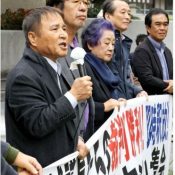
December 21, 2017 Ryukyu Shimpo
The public trial for Okinawa Peace Movement Center Chairman Hiroji Yamashiro and two others was held at Naha District Court on December 20 (Judge Toshihiro Shibata presiding).
The accused are facing charges including forcible obstruction of official business, obstruction of performance of public duty, and inflicting bodily injury.
In their closing statement, the defense claimed that it would be unjust for the court to rule in favor of the prosecution, as this lawsuit it being used to suppress the citizens’ opposition movement to U.S. bases.
Toward the end of the closing statements, Yamashiro said, “The government should face charges for its discriminative policies toward Okinawa.”
The court will pass down its ruling on March 14 next year.
At the trial, the defense explained Okinawa’s history such as Satsuma’s invasion of the Ryukyu Kingdom, Japan’s annexation of the Ryukyu Islands, the Battle of Okinawa and the post-war period.
It pointed out that these events demonstrate the reality of discrimination against Okinawa and the base burden on Okinawa.
In addition, it implored the court to recognize that the U.S.-Japan Status of Forces Agreement crushes the Constitution underfoot, and to make a decision based on the principles laid forth in the Constitution.
In regard to the action the defendants took in piling blocks to prevent the hauling of materials being charged as forcible obstruction of official business, the defense claimed that infringing on citizens’ freedom of speech is unconstitutional.
The defense pleaded innocent on all counts with the exception of the property damage charge.
On December 4 the prosecution delivered its closing argument, including in it that the defendants implemented illegal means, which are unjustifiable, in pursuit of their principles.
It recommended that Yamashiro face two years and six months imprisonment and hard labor.
According to the charge sheet, in January 2016 Chairman Yamashiro piled blocks in front of a Camp Schwab gate used for construction in Henoko, Nago City, to obstruct the work hauling in materials.
Before the trial a group of about 180 supporters of Yamashiro’s gathered in Gusukudake Park close to the Naha District Court.
They raised their voices fervently to cheer Yamashiro on in his trial; “Let’s do our best until the very end.”
(English translation by T&CT and Erin Jones)
Go to Japanese
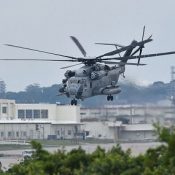
December 19, 2017 Ryukyu Shimpo Digital Edition
Following the accident in which a window from an U.S. military heavy-lift cargo helicopter Sikorsky CH-53E Super Stallion fell into the Futenma Daini Elementary School, the same model aircraft resumed its operations in the afternoon of December 19.
Around 12:23 p.m., the first Super Stallion took off from U.S. military Futenma Air Station in Ginowan City of Okinawa Prefecture.
It appears that the aircraft forcibly resumed operations despite the prefecture and local citizens of Ginowan City requesting the discontinuation of flights.
The aircraft resumed operations while accidents of U.S. military aircrafts continue to occur one after another.
Also, this occurred despite countermeasures to prevent further “human errors” have yet to be thoroughly implemented.
This “human error” was indicated during the Takae U.S. military helicopter fire accident that took place in October.
It seems that the pushback by the local citizens will intensify.
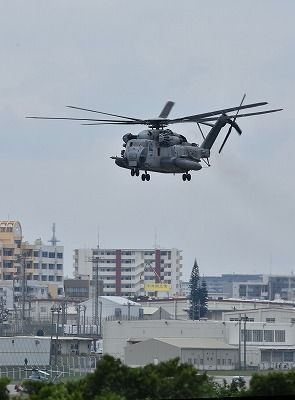
First heavy-lift cargo helicopter Sikorsky CH-53E Super Stallion taking off and resuming flight on December 19 at 12:24 p.m. in Kiyuna, Ginowan City (photograph taken by Keizo Shinzato)
On the morning of December 19, military personnel had been seen working around the Super Stallion at the U.S. military Futenma Air Station.
It seems that they were preparing the aircraft to resume operations.
Around 11:23 a.m., the propellers began to rotate, then the aircraft began to move about the runway, but then the engine was turned off.
The propellers to first Super Stallion began to rotate again around 12:22 p.m., it then took off and flew towards the northeast direction.
By 1:02 p.m., a second Super Stallion took off from the Futenma Air Station.
After that, the second Super Stallion came back to the Futenma Air Station, then took off once again with another Super Stallion around 1:07 p.m. By 2:03 p.m., a fourth Super Stallion took off.
The flight of the Super Stallion helicopter could be seen from the Futenma Daini Elementary School in which a separate Super Stallion had dropped a window into the grounds.
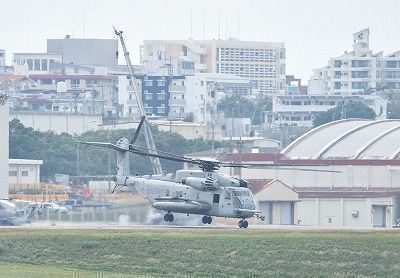
Heavy-lift cargo helicopter Sikorsky CH-53E Super Stallion after repeating take-off and landing on December 19 around 11:55 a.m. in Kiyuna, Ginowan City (photograph taken by Keizo Shinzato)
Meanwhile, the first Super Stallion that had been rotating its propellers since 11:23 a.m. repeated take-off and landing for a short time, then cut the engine on the runway.
It was then pulled away by a tow car and was returned to its original location before it came to the runway.
(English translation by T&CT and Chelsea Ashimine)
Go to Japanese
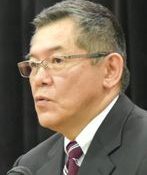
December 17, 2017 Ryukyu Shimpo
A symposium for brainstorming policies to preserve and pass down traditional Okinawan karate to later generations, titled, “Where did karate come from,” was held December 16 at the Yui-no-machi Research Center in Urasoe City (hosted by the symposiums executive committee).
The symposium was attended by around 220 people from the karate world, and served to reaffirm the importance in preserving and passing down traditional Okinawan karate to future generations.
Author Bin Konno took the lectern to give his concerns that while karate has been added as an official event at the 2020 Tokyo Olympics, he said, “If the sport is only talked about as a sport, we run the risk of people no longer practicing traditional Okinawan karate.”
He stressed that in order to protect against this, “We should continue to send the message that, ‘traditional Okinawan karate is culture,’ as part of the allure.”
Okinawa Karate Federation President Zenpo Shimabukuro critiqued, “The ‘sportification’ of karate deviates from its traditional Okinawan origin,” and further proclaimed, “The Okinawa karate world needs to be more unified and cohesive, with the intent of advancing the preservation and continuation of traditional karate.”
Other luminaries of the Okinawa karate community made resolutions such as, “There is value in keeping traditional Okinawan karate unchanged in perpetuity,” and, “We must strive to pass down Okinawan karate to later generations without losing its essence.”
(English translation by T&CT and Sam Grieb)
Go to Japanese












 Webcam(Kokusai Street)
Webcam(Kokusai Street)


